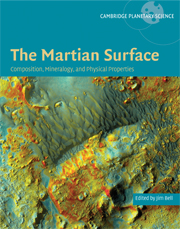Book contents
- Frontmatter
- Contents
- List of contributors
- Foreword
- Acknowledgments
- Part I Introduction and historical perspective
- Part II Elemental Composition: Orbital and in situ Surface Measurements
- Part III Mineralogy and Remote Sensing of Rocks, Soil, Dust, and Ices
- Part IV Physical Properties of Surface Materials
- Part V Synthesis
- 22 Implications of observed primary lithologies
- 23 Aqueous alteration on Mars
- 24 The sedimentary rock cycle of Mars
- 25 Martian polar processes
- 26 Astrobiological implications of Mars' surface composition and properties
- Part VI Summary, Upcoming Missions, and New Measurement Needs
- Index
- Plate section
- References
22 - Implications of observed primary lithologies
from Part V - Synthesis
Published online by Cambridge University Press: 10 December 2009
- Frontmatter
- Contents
- List of contributors
- Foreword
- Acknowledgments
- Part I Introduction and historical perspective
- Part II Elemental Composition: Orbital and in situ Surface Measurements
- Part III Mineralogy and Remote Sensing of Rocks, Soil, Dust, and Ices
- Part IV Physical Properties of Surface Materials
- Part V Synthesis
- 22 Implications of observed primary lithologies
- 23 Aqueous alteration on Mars
- 24 The sedimentary rock cycle of Mars
- 25 Martian polar processes
- 26 Astrobiological implications of Mars' surface composition and properties
- Part VI Summary, Upcoming Missions, and New Measurement Needs
- Index
- Plate section
- References
Summary
ABSTRACT
Data from Martian meteorites, orbital remote-sensing instruments, and in situ measurements at robotic landing sites reveal that Mars has a heterogeneous surface composition. We use these data to infer the compositional and mineralogical nature of Martian igneous rocks. Basaltic rocks dominate, but highly mafic magmas also formed, producing cumulate rocks inside lava flows. Cumulate rocks also formed in intrusions. Evolved, silicic rocks occur, but are not abundant. The diversity of igneous rocks indicates several distinctive source regions in the Martian mantle. These sources probably formed early in Martian history as the result of crystallization in a magma ocean followed by overturn of an unstable cumulate pile. Shergottites alone represent at least two distinct mantle sources (assuming no crustal assimilation), with mixing between them, but could represent several distinct sources on the basis of initial Sr-isotopic compositions. The nakhlites may represent a somewhat complementary source, but there is clearly an additional source with subchondritic Ba/La. Surface Types 1 and 2 are probably composed of multiple types of igneous rock, possibly mixed with altered materials, and on average are different in trace element (K, Th) and Fe abundances. They may be derived from distinct mantle source regions. The crust appears to have been constructed by basaltic magmatism, some associated with primary differentiation (probably a magma ocean), the rest formed by partial melting during mantle overturn and other dynamic processes.
- Type
- Chapter
- Information
- The Martian SurfaceComposition, Mineralogy and Physical Properties, pp. 501 - 518Publisher: Cambridge University PressPrint publication year: 2008
References
- 6
- Cited by

